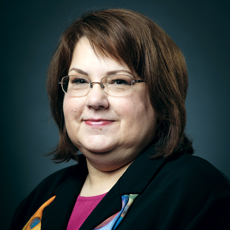
In 2015, the housekeeping and infection control team at Ovation Communities in Milwaukee, WI, were introduced to a new member of the team: a 3 ½-foot robot named Nikki—a word that means “to clean” in Hebrew.
Nikki is actually a device that emits a pulsed-xenon high intensity ultraviolet light across the entire disinfecting spectrum known as UV-C (Xenex Inc.). The Xenex robot is commonly used in hospitals to disinfect operating rooms, but we are the first nursing home in the country to test its effectiveness.
People living in long-term care settings are at increased risk for developing infections. Most transmission occurs from one person to another, but microbes can also be transmitted when people touch contaminated objects in the environment. Research has shown that environmental surfaces in nursing homes contain many illness-causing microbes, and that many types of bacteria can persist on dry surfaces for months. Chemical disinfectants are not highly effective at eradicating viruses and spore producing bacteria, and the thoroughness of disinfection depends on the diligence of the housekeeping staff.
Our research at Ovation Communities was designed to determine if the regular and systematic use of the pulsed-xenon ultraviolet disinfection device would decrease: 1) Microbes on environmental surfaces 2) Infection rates and 3) Infection-related hospitalizations.
There were 247 discharges over the course of a year at this 160-bed long-term care community. Following a resident discharge, the housekeeping staff cleaned the room and wiped down high-touch surfaces using a sodium hypochlorite and detergent cleaning agent. Surfaces such as telephone handsets and TV remotes were then turned so that they would be exposed to ultraviolet light during Nikki’s operation. The ultraviolet disinfection device beamed a pulsing light for 5 minutes each in three locations: two bedroom locations and the bathroom. Before exposure in the second bedroom location, some surfaces were again shifted to maximize exposure to ultraviolet light (e.g. handset of phone turned over, door position changed). Shared rooms such as the dining rooms and activity rooms received daily cleaning and weekly ultraviolet disinfection. The ultraviolet disinfection light cleans and reaches surfaces not completely and routinely cleaned by staff such as curtains, doors, and lamps.
The presence of adenosine triphosphate on an environmental surface indicates that microorganisms that support bacterial growth or other organic contaminants are on the surface. We swabbed high touch surfaces for ATP before cleaning and after the room had received both cleaning and ultraviolet room disinfection. All surfaces showed large decreases in ATP counts after cleaning and ultraviolet light disinfection. For example, the call light went from a median ATP reading of 231 (Range 2 to 6054) to 2 (Range 0 to 1722).
In 30 rooms, we cultured high-touch surfaces at three time points: Before cleaning, after cleaning but before ultraviolet light disinfection, and after the ultraviolet light disinfection. Twenty-one of the 30 rooms (70%) had either a gram-positive cocci or rod on one of the high touch environmental surfaces for one testing time or more. Seventy-six percent of the enabler bars, 67% of the overbed tables, and 20% of the faucet handles tested positive at baseline. There were statistically significantly changes between baseline, post cleaning, and post ultraviolet light disinfection time points for the enabler bar and overbed table but not for the faucet handle. Culture results were positive for gram positive cocci or rods on 33% (n = 30) of the 90 surfaces swabbed at baseline. After disinfectant cleaning, 6 of 90 samples (7.1%) tested positive for a gram-positive bacilli, and after ultraviolet disinfection 4 of the 90 samples (4.4%) were positive.
We compared infection rates and infection-related hospitalization rates between the year of pulsed-xenon ultraviolet disinfection and the three previous years. Because of large increases in hospital-acquired infection rates for each year we studied, nursing home acquired infection rates were compared relative to hospital-acquired infection rates. There were statistically significant decreases in nursing home acquired relative to hospital-acquired infection rates. Specifically, we found significant decreases in infection rates of the urinary tract, respiratory system, skin and soft tissues. Enteric infections occurred at such a low rate that these data could not be compared. Hospitalizations for infection decreased significantly, with a notable decrease in hospitalization for pneumonia.
Last year, Nikki, clad in a party hat and lei, was lauded at a one-year birthday celebration for “his” ability to “bring sunshine to every place he goes.” While the staff has had some fun naming and partying with our new robot, we are all very aware that infections acquired in long-term care settings are serious concerns. Our study showed that the pulsed-xenon ultraviolet disinfection device is superior to manual cleaning alone for decreasing microbes on environmental surfaces, as well as decreasing infection rates and the rates of hospitalization for infection. The link to the the full study description that was published in BMC: Infectious Disease can be read here.
Christine R. Kovach is the Jewish Home and Care Center Research Professor in Aging at the University of Wisconsin-Milwaukee and the Director of Research for Ovation Communities.



